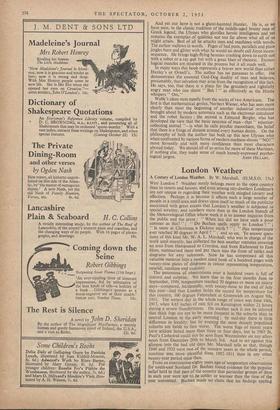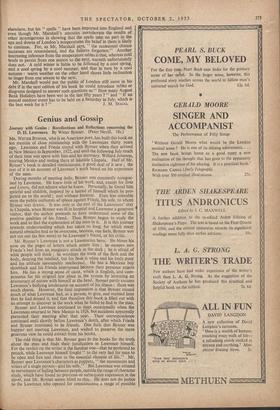London Weather
A Century of London Weather. By W. Marshall. (H.M.S.O. 15s.) WHY London ? Weather surely belongs more to the open country than to streets and houses, and even among city-dwellers Londoners are not unique in regarding their weather with mingled z.nxiety and affection. Perhaps it is because it affects such a large number of people in a small area and draws upon itself so much of the publicity associated with great events that London's weather is subjected to special scrutiny, and nowhere more than in the London branch of the Meteorological Office whose work it is to answer inquiries from the public and the press : " When last did we have such a poor summer as this? " ; " Do Buchan spells apply to London ? " ; " Is snow at Christmas a Dickens myth ? " ; Has temperature ever reached 80 degrees in April ? " ; and so on. To answer ques- tions of this kind Mr. W. A. L. Marshall, who was in charge of the work until recently, has collected the best weather statistics covering an area from Hampstead to Croydon, and from Richmond to East Ham, summarised them and put them into the form of tables and diagrams for easy reference. Now he has compressed all this valuable material into a modest sized book of a hundred pages with twenty-nine plates of diagrams in colour representing, temperature, rainfall, sunshine and visibility. The panorama of observations over a hundred years is full of interest and surprise. We learn that in the four months June to September, 1949, temperature reached 70 degrees or more on ninety days—compared, incidentally, with twenty-three to the end of July this year—and that London holds the record for temperature for this country, 100 degrees Fahrenheit at Greenwich on August 9th, 1911. The wettest day in the whole range of years was June 16th, 1917, when 4.65 inches of rain fell on Kensington within 2} hours during a severe thunderstorm. On another tack it can be inferred that thick fogs are apt to be more frequent in the suburbs than in central London in the early morning ; by mid-day there is little ' difference in locality, but by evening the most densely populated suburbs are liable to fare worst. The worst fogs of recent years have seldom lasted more than three or four days, but in 1903 St. Paul's Cathedral could not be seen from Westminster on any after- noon from December 20th to March 3rd. And to set against this glimpse into the bad old days Mr. Marshall tells us that, though 1949 and 1933 were two of the sunniest years in the whole period, sunshine was more plentiful from 1892-1911 than in any other . • twenty-year period since then. From an examination eighty years ago of temperature observations for south-east Scotland Dr. Buchan found evidence for the popular belief held in that part of the country that particular groups of days in each year were apt to be colder or warmer than the time of the year warranted. Buchan made no claim that his findings applied elsewhere, but his " spells " have been imported into England and even though Mr. Marshall's statistics corroborate the results of other investigations in showing that the spells take no part in the ups and downs of London's temperatures the belief in them is likely to continue. For, as Mr. Marshall says, " the occasional chance successes are remembered, and the failures forgotten." Another interesting inference from the temperature tables is that, whereas cold tends to persist from one season to the next, warmth unfortunately does not. A cold winter is liable to be followed by a cool spring, and a cool spring by a cool summer, and that in turn by a cool autumn : warm weather on the other hand shows little inclination to linger from one season to the next. Mr. Marshall would put the public of London still more in his debt if in the next edition of his book he could introduce tables or diagrams designed to answer such questions as " How many August Bank Holidays have been wet in the last fifty years ? " and " If an annual outdoor event has to be held on a Saturday in July, which is



















































 Previous page
Previous page